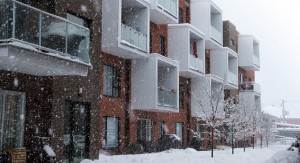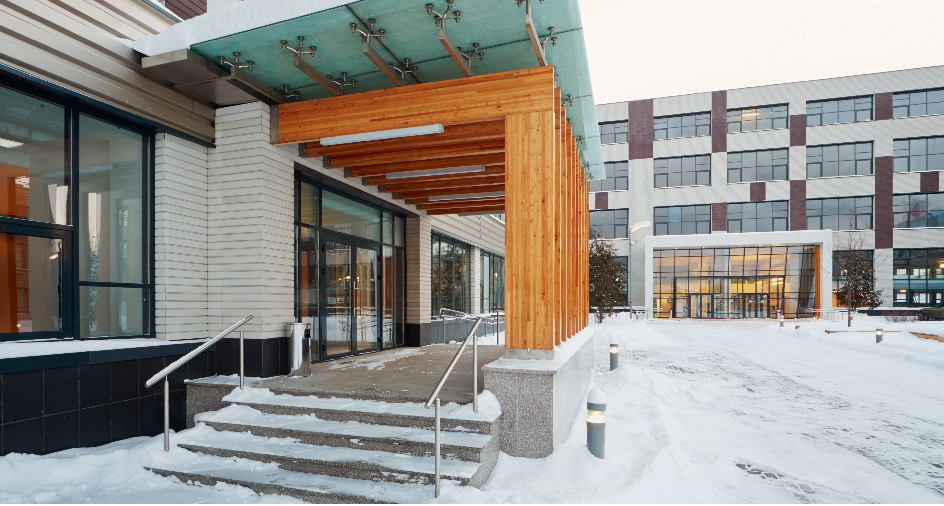Even the toughest commercial buildings can fall prey to Canadian winters. Harsh storms, heavy snow, and heightened water damage risks can jeopardize critical systems and infrastructure while putting occupants and visitors at risk. Still, as is always true in property management, being proactive pays.
“Every winter introduces a host of potential hazards, all of which can affect the safety and structure of your properties. And if winter-related damage isn’t prevented or detected until spring, you could be looking at additional issues and costly repairs,” says Craig Smith, Director of Commercial Business Development with FIRST ONSITE.
Surely, by identifying and addressing potential winter risks, commercial property managers and owners can take preventative measures to protect their assets and keep tenants safe and comfortable.
It begins with a plan
 The first step in winterizing a commercial property is to create a game plan. Collaborate with your facilities team and disaster prevention specialists to design a winter-preparedness plan that your teams can follow throughout the winter to ensure your
The first step in winterizing a commercial property is to create a game plan. Collaborate with your facilities team and disaster prevention specialists to design a winter-preparedness plan that your teams can follow throughout the winter to ensure your
building and its occupants stay protected.
Key components of a commercial property winter plan include:
- Building assessments & routine inspections: Knowing where your building is most vulnerable to winter damage is the first step in cold-weather preparedness. Walk the property with your facilities teams and specialists to size up potential structural issues and maintenance needs that need addressing before the snow, sleet, and cold set in.
And don’t just stop at one. Continue conducting building inspections throughout the cold months to keep track of your building’s condition. This is especially important after a storm or during extreme temperature dips when even the slightest damage (e.g., cracks, tears, water leakage, etc.) can evolve into costly and unsafe issues. - Prevent flooding and water damage: Water from melting snow and ice can damage commercial properties if given a chance to seep in. Seal, repair, or address any deficiencies on your roof, building envelope, or foundation that may facilitate water infiltration (e.g., cracks, holes, weaknesses, etc.), and remove snow piles on the roof or near the foundation that may thaw and pose additional water issues. Remember: when a water emergency happens, you need to catch it quickly. For this reason, many multifamily property managers/owners have found it beneficial to install water monitoring and leak detection technology that alerts the appropriate responders to potential water events the moment they begin to occur.
- Control exterior water access: Turn off water access to outside faucets to avoid pipes from freezing and bursting, which could lead to flooding. Similarly, shut down irrigation systems to preserve them through the winter and avoid problems in the spring.
- Protect your pipes: Seal or block drafty areas in a building where pipes may be exposed to freezing temperatures, and wrap pipes to insulate them from freezing or cracking. Doing so will keep heating systems in working order and will go a long way toward preventing the aforementioned risks of water damage.
- Install backwater valves: Melting snow or ice can push municipal water systems to their limit, sending dirty, unsafe water back into a building’s system and necessitating a property restoration team and sophisticated cleaning methods. Avoid backwater by installing a mainline sewer backup valve that makes sure sewage travels on a one-way path out of the building.
- Prevent snow and ice build-up: Prevent snow from piling up on roofs and supporting structures. Heavy snow loads can lead to structural damage or collapse, leading to costly repairs and – more importantly – putting building users at risk. Similarly, excessive ice build-up on roofs can jeopardize the integrity of the building and pose safety risks for residents below. On the topic of ice, inspect meters, door locks, and door handles on the ground level, as they may freeze due to melting water from higher surfaces dripping down and reforming as ice.
- Keep entrances and exits clear: Make sure all points of entry and exit are continually cleared of snow and ice so they can be used safely in the case of an emergency. This can be done by placing sand, salt, and shovels in an accessible area or hiring a snow removal company ahead of time to clear sidewalks, parking lots, and roads when needed.
- Don’t forget about fires: The risks of a fire are always a concern. Collaborate with your fire department to mark the hydrants close to your business property above the snow line so they’re easier to locate. Also remember to clear space around hydrants after a snowstorm and check that all building extinguishers are full and working properly.
- Crack a door: While it may seem common sense to keep doors closed in a commercial building to keep the area warm, it is advisable to leave them open in areas prone to condensation and precipitation, as the continuous air flow will minimize cold spots and help prevent moisture build-up.
Ready to react
Even the most prepared commercial property may experience an emergency. Herein, one of the most important things to consider as winter approaches is that an emergency plan is in place.
 Emergency preparedness plans include considerations for evacuation plans and routes, ensuring life safety systems are working (e.g., alarms and sprinklers), and that people are assigned to close off water, gas, and electricity to avoid property damage from fires or flooding. They should also include contacts for emergency services (fire, ambulatory, and police), insurance reps, and a trusted property restoration partner.
Emergency preparedness plans include considerations for evacuation plans and routes, ensuring life safety systems are working (e.g., alarms and sprinklers), and that people are assigned to close off water, gas, and electricity to avoid property damage from fires or flooding. They should also include contacts for emergency services (fire, ambulatory, and police), insurance reps, and a trusted property restoration partner.
“There are a lot of steps you can take to prevent a winter disaster, but when an unpredictable winter event occurs, it is also imperative to have an emergency preparedness plan for your business,” adds Smith.

Craig Smith is Director of Commercial Business Development with FIRST ONSITE, a leader in emergency response planning, disaster remediation, property restoration, and reconstruction services, helping clients restore, rebuild, and rise after catastrophic events of every kind.






